Paper Menu >>
Journal Menu >>
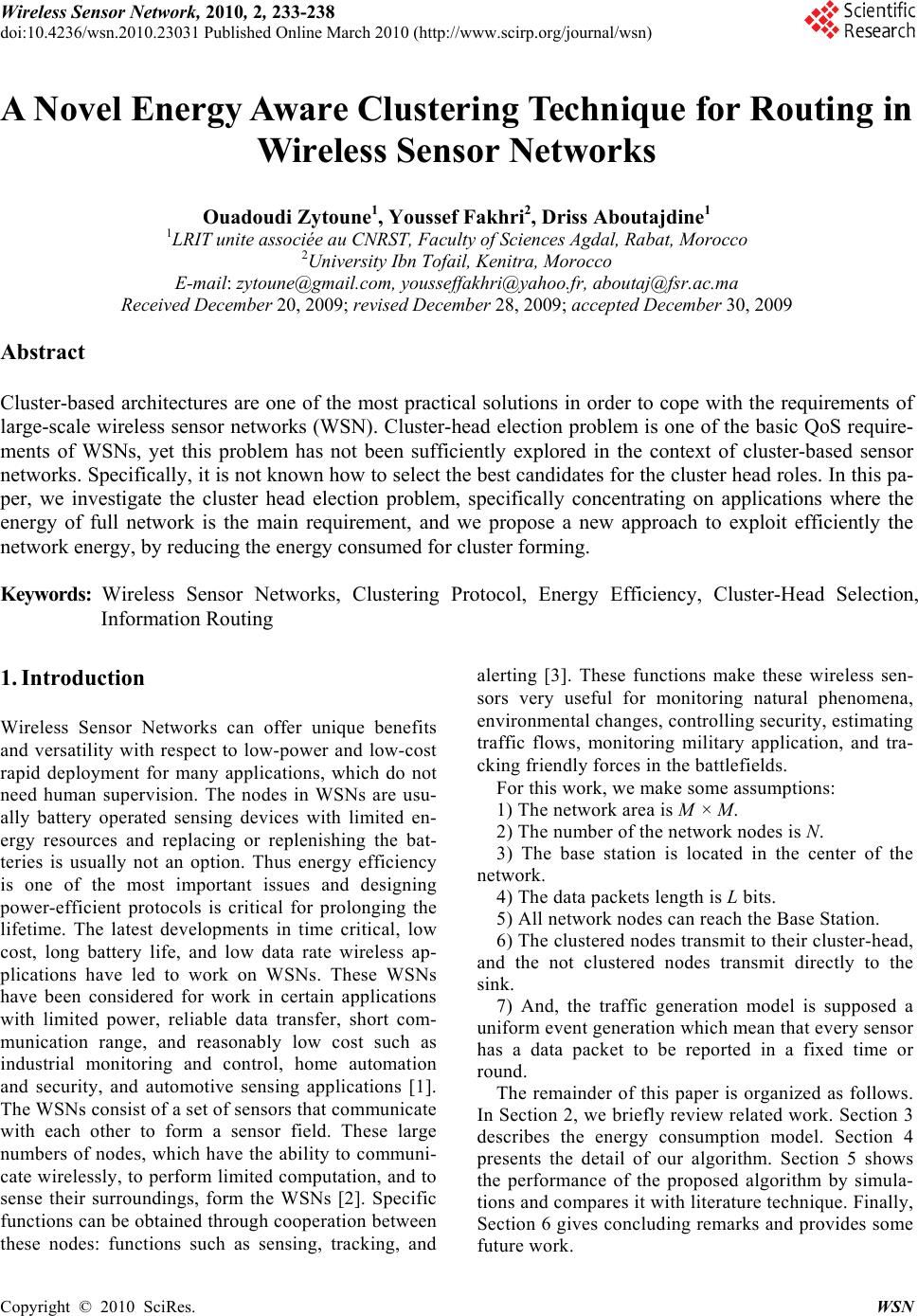 Wireless Sensor Network, 2010, 2, 233-238 doi:10.4236/wsn.2010.23031 Published Online March 2010 (http://www.scirp.org/journal/wsn) Copyright © 2010 SciRes. WSN A Novel Energy Aware Clustering Technique for Routing in Wireless Sensor Networks Ouadoudi Zytoune1, Youssef Fakhri2, Driss Aboutajdine1 1LRIT unite associée au CNRST, Faculty of Sciences Agdal, Rabat, Morocco 2University Ibn Tofail, Kenitra, Morocco E-mail: zytoune@gmail.com, yousseffakhri@yahoo.fr, aboutaj@fsr.ac.ma Received December 20, 2009; revised December 28, 2009; accepted December 30, 2009 Abstract Cluster-based architectures are one of the most practical solutions in order to cope with the requirements of large-scale wireless sensor networks (WSN). Cluster-head election problem is one of the basic QoS require- ments of WSNs, yet this problem has not been sufficiently explored in the context of cluster-based sensor networks. Specifically, it is not known how to select the best candidates for the cluster head roles. In this pa- per, we investigate the cluster head election problem, specifically concentrating on applications where the energy of full network is the main requirement, and we propose a new approach to exploit efficiently the network energy, by reducing the energy consumed for cluster forming. Keywords: Wireless Sensor Networks, Clustering Protocol, Energy Efficiency, Cluster-Head Selection, Information Routing 1. Introduction Wireless Sensor Networks can offer unique benefits and versatility with respect to low-power and low-cost rapid deployment for many applications, which do not need human supervision. The nodes in WSNs are usu- ally battery operated sensing devices with limited en- ergy resources and replacing or replenishing the bat- teries is usually not an option. Thus energy efficiency is one of the most important issues and designing power-efficient protocols is critical for prolonging the lifetime. The latest developments in time critical, low cost, long battery life, and low data rate wireless ap- plications have led to work on WSNs. These WSNs have been considered for work in certain applications with limited power, reliable data transfer, short com- munication range, and reasonably low cost such as industrial monitoring and control, home automation and security, and automotive sensing applications [1]. The WSNs consist of a set of sensors that communicate with each other to form a sensor field. These large numbers of nodes, which have the ability to communi- cate wirelessly, to perform limited computation, and to sense their surroundings, form the WSNs [2]. Specific functions can be obtained through cooperation between these nodes: functions such as sensing, tracking, and alerting [3]. These functions make these wireless sen- sors very useful for monitoring natural phenomena, environmental changes, controlling security, estimating traffic flows, monitoring military application, and tra- cking friendly forces in the battlefields. For this work, we make some assumptions: 1) The network area is M × M. 2) The number of the network nodes is N. 3) The base station is located in the center of the network. 4) The data packets length is L bits. 5) All network nodes can reach the Base Station. 6) The clustered nodes transmit to their cluster-head, and the not clustered nodes transmit directly to the sink. 7) And, the traffic generation model is supposed a uniform event generation which mean that every sensor has a data packet to be reported in a fixed time or round. The remainder of this paper is organized as follows. In Section 2, we briefly review related work. Section 3 describes the energy consumption model. Section 4 presents the detail of our algorithm. Section 5 shows the performance of the proposed algorithm by simula- tions and compares it with literature technique. Finally, Section 6 gives concluding remarks and provides some future work. 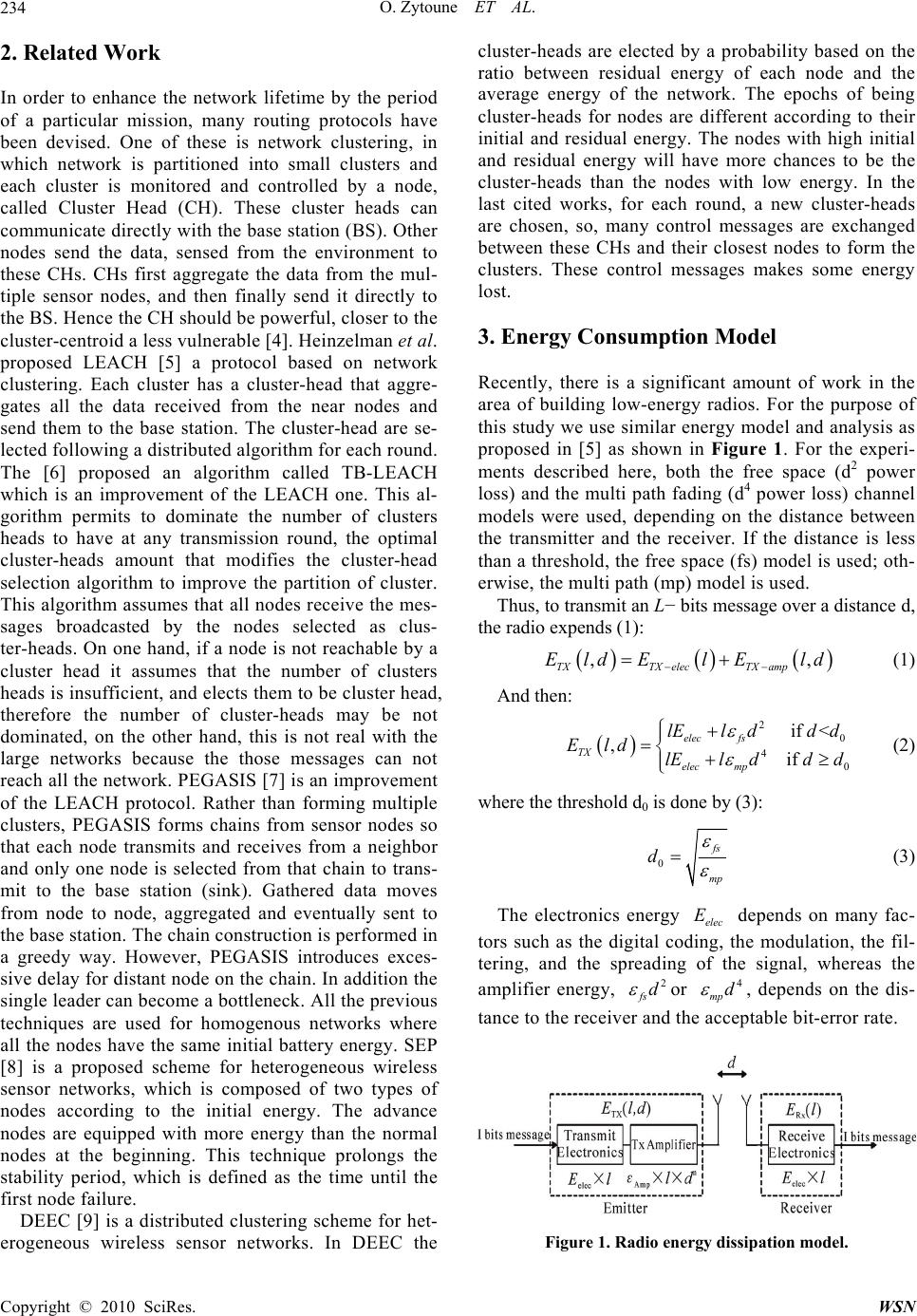 O. Zytoune ET AL. 234 2. Related Work In order to enhance the network lifetime by the period of a particular mission, many routing protocols have been devised. One of these is network clustering, in which network is partitioned into small clusters and each cluster is monitored and controlled by a node, called Cluster Head (CH). These cluster heads can communicate directly with the base station (BS). Other nodes send the data, sensed from the environment to these CHs. CHs first aggregate the data from the mul- tiple sensor nodes, and then finally send it directly to the BS. Hence the CH should be powerful, closer to the cluster-centroid a less vulnerable [4]. Heinzelman et al. proposed LEACH [5] a protocol based on network clustering. Each cluster has a cluster-head that aggre- gates all the data received from the near nodes and send them to the base station. The cluster-head are se- lected following a distributed algorithm for each round. The [6] proposed an algorithm called TB-LEACH which is an improvement of the LEACH one. This al- gorithm permits to dominate the number of clusters heads to have at any transmission round, the optimal cluster-heads amount that modifies the cluster-head selection algorithm to improve the partition of cluster. This algorithm assumes that all nodes receive the mes- sages broadcasted by the nodes selected as clus- ter-heads. On one hand, if a node is not reachable by a cluster head it assumes that the number of clusters heads is insufficient, and elects them to be cluster head, therefore the number of cluster-heads may be not dominated, on the other hand, this is not real with the large networks because the those messages can not reach all the network. PEGASIS [7] is an improvement of the LEACH protocol. Rather than forming multiple clusters, PEGASIS forms chains from sensor nodes so that each node transmits and receives from a neighbor and only one node is selected from that chain to trans- mit to the base station (sink). Gathered data moves from node to node, aggregated and eventually sent to the base station. The chain construction is performed in a greedy way. However, PEGASIS introduces exces- sive delay for distant node on the chain. In addition the single leader can become a bottleneck. All the previous techniques are used for homogenous networks where all the nodes have the same initial battery energy. SEP [8] is a proposed scheme for heterogeneous wireless sensor networks, which is composed of two types of nodes according to the initial energy. The advance nodes are equipped with more energy than the normal nodes at the beginning. This technique prolongs the stability period, which is defined as the time until the first node failure. DEEC [9] is a distributed clustering scheme for het- erogeneous wireless sensor networks. In DEEC the cluster-heads are elected by a probability based on the ratio between residual energy of each node and the average energy of the network. The epochs of being cluster-heads for nodes are different according to their initial and residual energy. The nodes with high initial and residual energy will have more chances to be the cluster-heads than the nodes with low energy. In the last cited works, for each round, a new cluster-heads are chosen, so, many control messages are exchanged between these CHs and their closest nodes to form the clusters. These control messages makes some energy lost. 3. Energy Consumption Model Recently, there is a significant amount of work in the area of building low-energy radios. For the purpose of this study we use similar energy model and analysis as proposed in [5] as shown in Figure 1. For the experi- ments described here, both the free space (d2 power loss) and the multi path fading (d4 power loss) channel models were used, depending on the distance between the transmitter and the receiver. If the distance is less than a threshold, the free space (fs) model is used; oth- erwise, the multi path (mp) model is used. Thus, to transmit an L− bits message over a distance d, the radio expends (1): ,, TXTX elecTX amp Eld ElEld (1) And then: 2 0 4 0 if < ,if elec fs TX elec mp lEldd d Eld lEldd d (2) where the threshold d0 is done by (3): 0 fs mp d (3) The electronics energy depends on many fac- tors such as the digital coding, the modulation, the fil- tering, and the spreading of the signal, whereas the amplifier energy, or , depends on the dis- tance to the receiver and the acceptable bit-error rate. elec E mp d 2 fs d 4 Figure 1. Radio energy dissipation model. Copyright © 2010 SciRes. WSN 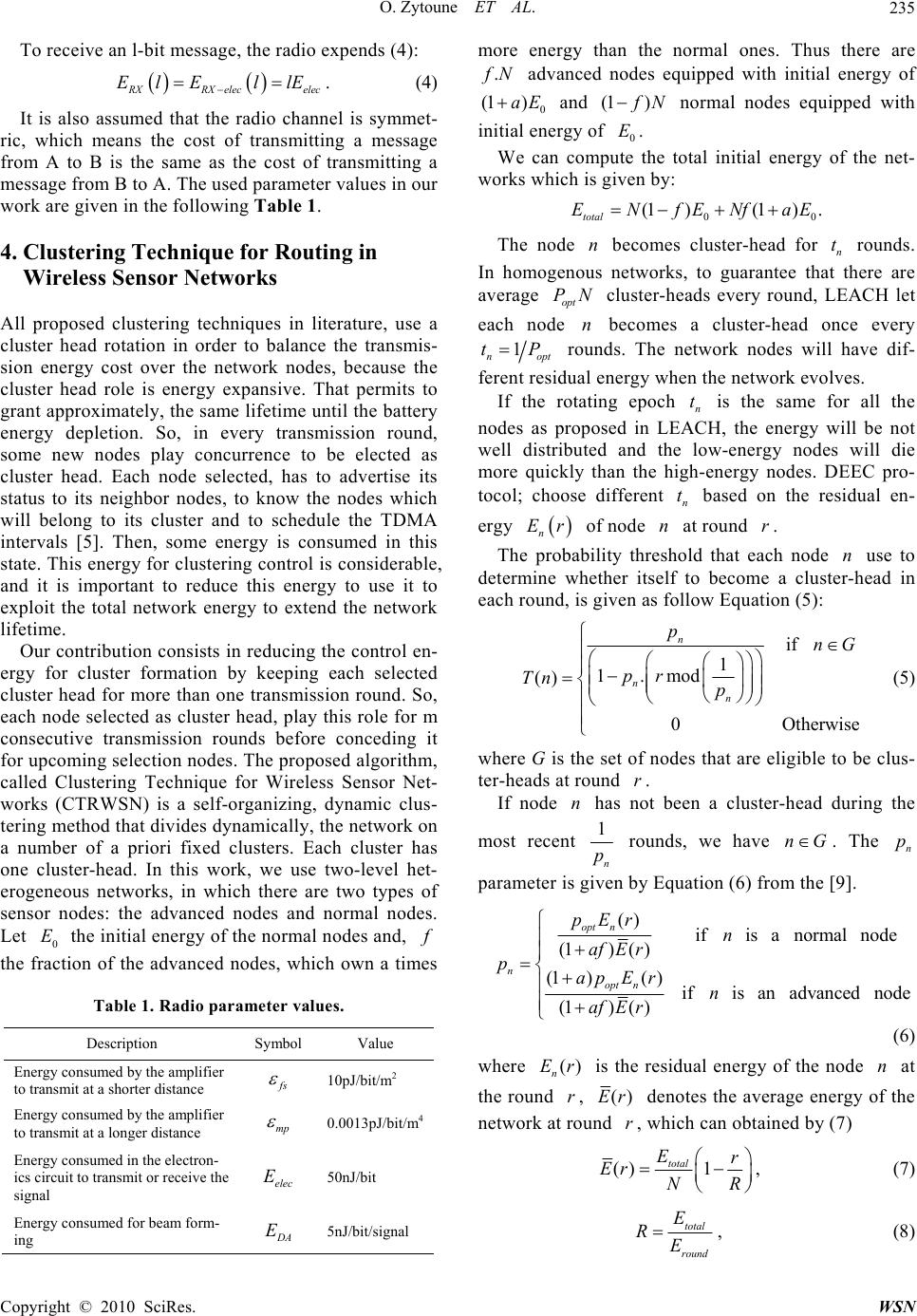 O. Zytoune ET AL.235 To receive an l-bit message, the radio expends (4): R XRXelec ElE llE elec . (4) It is also assumed that the radio channel is symmet- ric, which means the cost of transmitting a message from A to B is the same as the cost of transmitting a message from B to A. The used parameter values in our work are given in the following Table 1. 4. Clustering Technique for Routing in Wireless Sensor Networks All proposed clustering techniques in literature, use a cluster head rotation in order to balance the transmis- sion energy cost over the network nodes, because the cluster head role is energy expansive. That permits to grant approximately, the same lifetime until the battery energy depletion. So, in every transmission round, some new nodes play concurrence to be elected as cluster head. Each node selected, has to advertise its status to its neighbor nodes, to know the nodes which will belong to its cluster and to schedule the TDMA intervals [5]. Then, some energy is consumed in this state. This energy for clustering control is considerable, and it is important to reduce this energy to use it to exploit the total network energy to extend the network lifetime. Our contribution consists in reducing the control en- ergy for cluster formation by keeping each selected cluster head for more than one transmission round. So, each node selected as cluster head, play this role for m consecutive transmission rounds before conceding it for upcoming selection nodes. The proposed algorithm, called Clustering Technique for Wireless Sensor Net- works (CTRWSN) is a self-organizing, dynamic clus- tering method that divides dynamically, the network on a number of a priori fixed clusters. Each cluster has one cluster-head. In this work, we use two-level het- erogeneous networks, in which there are two types of sensor nodes: the advanced nodes and normal nodes. Let the initial energy of the normal nodes and, 0 E f the fraction of the advanced nodes, which own a times Table 1. Radio parameter values. Description Symbol Value Energy consumed by the amplifier to transmit at a shorter distance fs 10pJ/bit/m2 Energy consumed by the amplifier to transmit at a longer distance mp 0.0013pJ/bit/m4 Energy consumed in the electron- ics circuit to transmit or receive the signal elec E 50nJ/bit Energy consumed for beam form- ing D A E 5nJ/bit/signal more energy than the normal ones. Thus there are . f N (1 advanced nodes equipped with initial energy of 0 )aE and (1 ) f N normal nodes equipped with initial energy of . 0 E We can compute the total initial energy of the net- works which is given by: 00 (1)(1) . total ENfENfaE The node becomes cluster-head for rounds. In homogenous networks, to guarantee that there are average cluster-heads every round, LEACH let each node becomes a cluster-head once every n N n n t opt P 1 nopt Pt rounds. The network nodes will have dif- ferent residual energy when the network evolves. If the rotating epoch is the same for all the nodes as proposed in LEACH, the energy will be not well distributed and the low-energy nodes will die more quickly than the high-energy nodes. DEEC pro- tocol; choose different t based on the residual en- ergy n t n n Er of node at round r. n The probability threshold that each node use to determine whether itself to become a cluster-head in each round, is given as follow Equation (5): n if 1 1.mod () 0Othe n n n pnG pr Tn p rwise (5) where G is the set of nodes that are eligible to be clus- ter-heads at round . r If node has not been a cluster-head during the most recent n 1 n p rounds, we have . The parameter is given by Equation (6) from the [9]. nGn p () ifis anormal node (1)( ) (1)( )ifis anadvanced node (1)( ) opt n n opt n pErn afE r papE rn afE r (6) where is the residual energy of the node at the round , () n Er r n ()Er denotes the average energy of the network at round , which can obtained by (7) r () 1 total Er Er NR , (7) total round E RE , (8) Copyright © 2010 SciRes. WSN 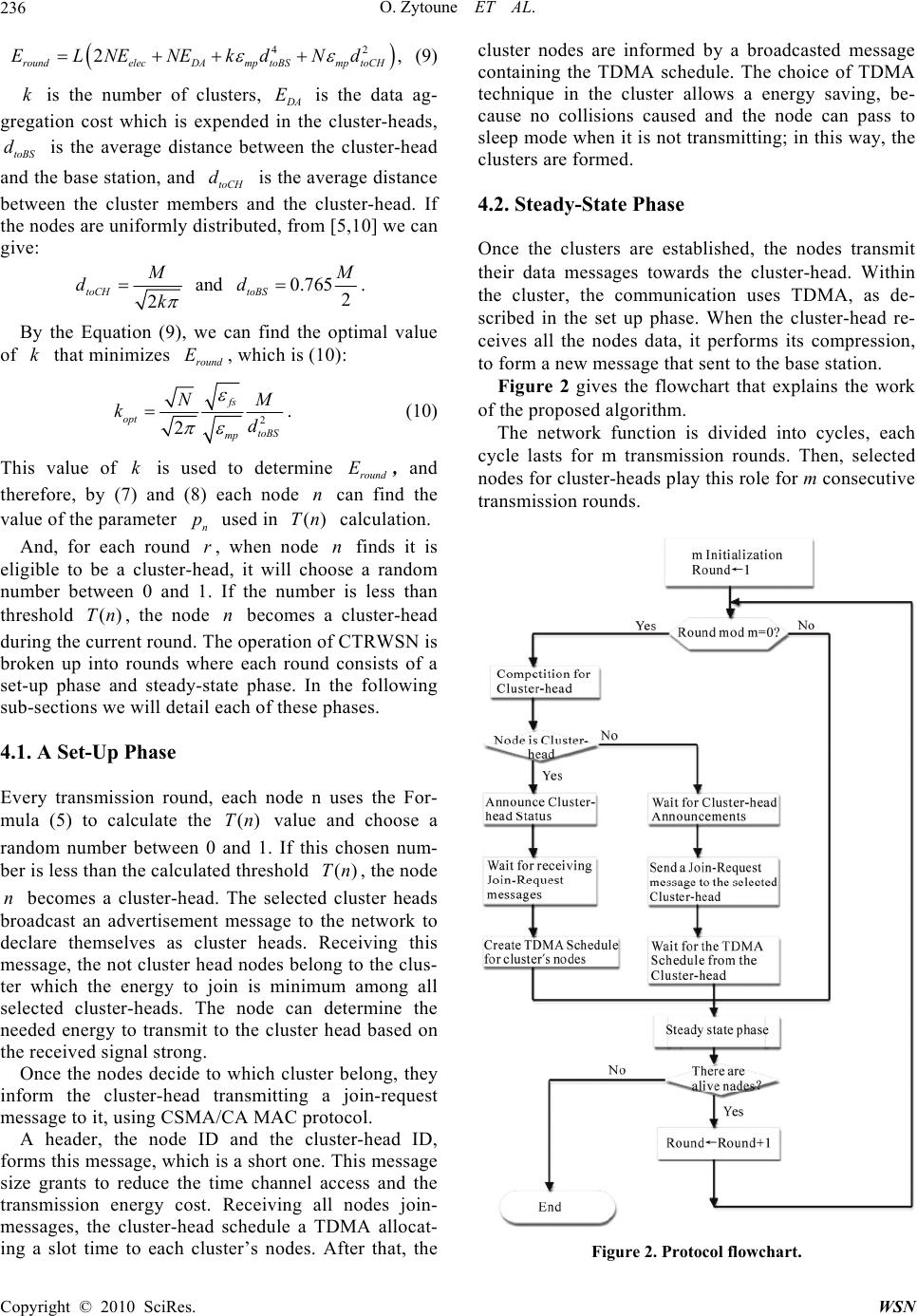 O. Zytoune ET AL. 236 , 42 2 roundelecDAmp toBSmp toCH EL NENEkdNd (9) k is the number of clusters, D A E is the data ag- gregation cost which is expended in the cluster-heads, is the average distance between the cluster-head and the base station, and is the average distance between the cluster members and the cluster-head. If the nodes are uniformly distributed, from [5,10] we can give: toBS d toCH d and0.765 2 2 toCH toBS M M dd k . By the Equation (9), we can find the optimal value of that minimizes , which is (10): kround E 2 2 fs opt toBS mp N kd M . (10) This value of is used to determine , and therefore, by (7) and (8) each node can find the value of the parameter used in calculation. kround E n ()Tn n p And, for each round , when node finds it is eligible to be a cluster-head, it will choose a random number between 0 and 1. If the number is less than threshold , the node becomes a cluster-head during the current round. The operation of CTRWSN is broken up into rounds where each round consists of a set-up phase and steady-state phase. In the following sub-sections we will detail each of these phases. rn ()Tn n 4.1. A Set-Up Phase Every transmission round, each node n uses the For- mula (5) to calculate the value and choose a random number between 0 and 1. If this chosen num- ber is less than the calculated threshold , the node becomes a cluster-head. The selected cluster heads broadcast an advertisement message to the network to declare themselves as cluster heads. Receiving this message, the not cluster head nodes belong to the clus- ter which the energy to join is minimum among all selected cluster-heads. The node can determine the needed energy to transmit to the cluster head based on the received signal strong. ()Tn ()Tn n Once the nodes decide to which cluster belong, they inform the cluster-head transmitting a join-request message to it, using CSMA/CA MAC protocol. A header, the node ID and the cluster-head ID, forms this message, which is a short one. This message size grants to reduce the time channel access and the transmission energy cost. Receiving all nodes join- messages, the cluster-head schedule a TDMA allocat- ing a slot time to each cluster’s nodes. After that, the cluster nodes are informed by a broadcasted message containing the TDMA schedule. The choice of TDMA technique in the cluster allows a energy saving, be- cause no collisions caused and the node can pass to sleep mode when it is not transmitting; in this way, the clusters are formed. 4.2. Steady-State Phase Once the clusters are established, the nodes transmit their data messages towards the cluster-head. Within the cluster, the communication uses TDMA, as de- scribed in the set up phase. When the cluster-head re- ceives all the nodes data, it performs its compression, to form a new message that sent to the base station. Figure 2 gives the flowchart that explains the work of the proposed algorithm. The network function is divided into cycles, each cycle lasts for m transmission rounds. Then, selected nodes for cluster-heads play this role for m consecutive transmission rounds. Figure 2. Protocol flowchart. Copyright © 2010 SciRes. WSN 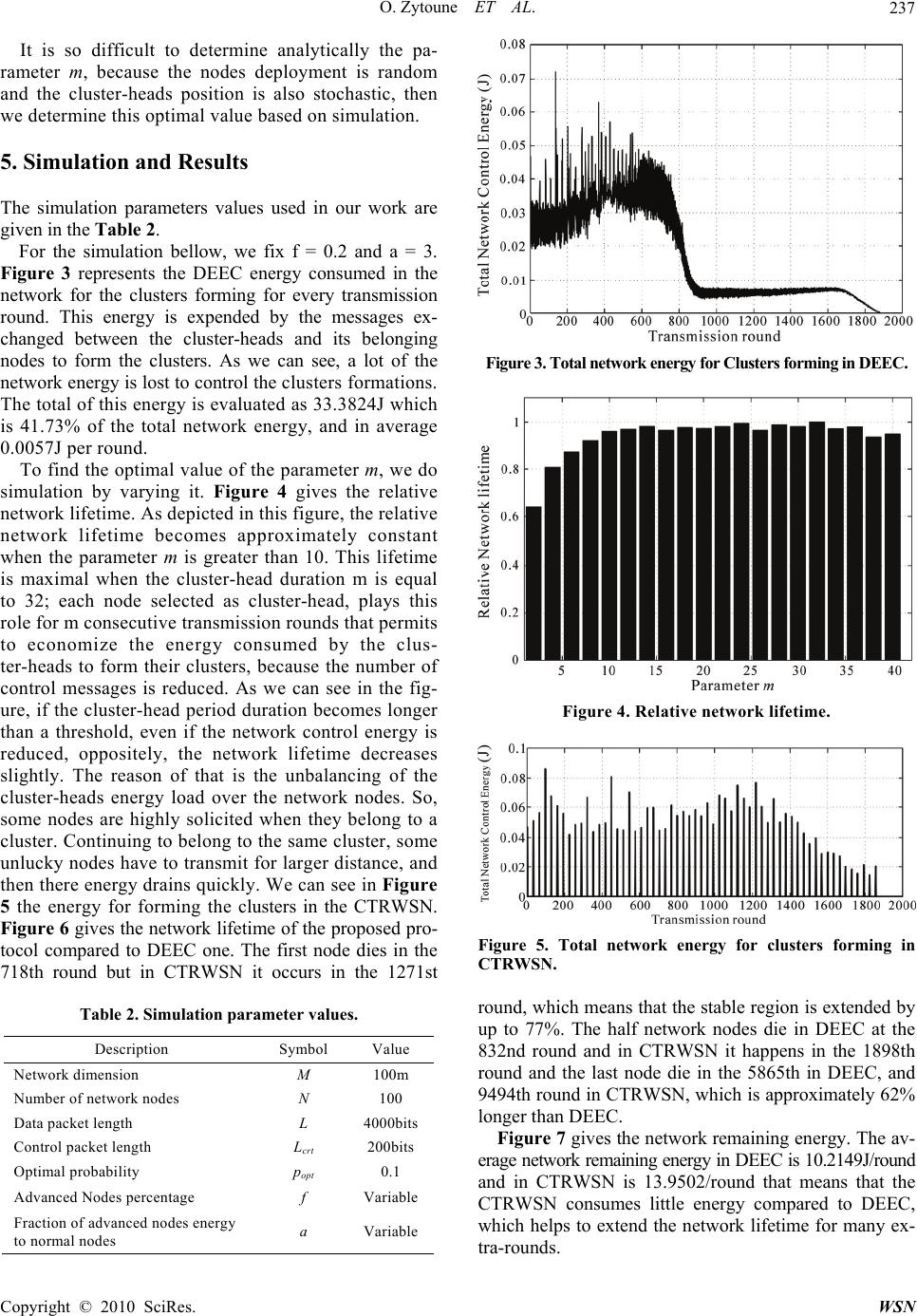 O. Zytoune ET AL.237 It is so difficult to determine analytically the pa- rameter m, because the nodes deployment is random and the cluster-heads position is also stochastic, then we determine this optimal value based on simulation. 5. Simulation and Results The simulation parameters values used in our work are given in the Table 2. For the simulation bellow, we fix f = 0.2 and a = 3. Figure 3 represents the DEEC energy consumed in the network for the clusters forming for every transmission round. This energy is expended by the messages ex- changed between the cluster-heads and its belonging nodes to form the clusters. As we can see, a lot of the network energy is lost to control the clusters formations. The total of this energy is evaluated as 33.3824J which is 41.73% of the total network energy, and in average 0.0057J per round. To find the optimal value of the parameter m, we do simulation by varying it. Figure 4 gives the relative network lifetime. As depicted in this figure, the relative network lifetime becomes approximately constant when the parameter m is greater than 10. This lifetime is maximal when the cluster-head duration m is equal to 32; each node selected as cluster-head, plays this role for m consecutive transmission rounds that permits to economize the energy consumed by the clus- ter-heads to form their clusters, because the number of control messages is reduced. As we can see in the fig- ure, if the cluster-head period duration becomes longer than a threshold, even if the network control energy is reduced, oppositely, the network lifetime decreases slightly. The reason of that is the unbalancing of the cluster-heads energy load over the network nodes. So, some nodes are highly solicited when they belong to a cluster. Continuing to belong to the same cluster, some unlucky nodes have to transmit for larger distance, and then there energy drains quickly. We can see in Figure 5 the energy for forming the clusters in the CTRWSN. Figure 6 gives the network lifetime of the proposed pro- tocol compared to DEEC one. The first node dies in the 718th round but in CTRWSN it occurs in the 1271st Table 2. Simulation parameter values. Description Symbol Value Network dimension M 100m Number of network nodes N 100 Data packet length L 4000bits Control packet length Lcrt 200bits Optimal probability popt 0.1 Advanced Nodes percentage f Variable Fraction of advanced nodes energy to normal nodes a Variable Figure 3. Total network energy for Clusters forming in DEEC. Figure 4. Relative network lifetime. Figure 5. Total network energy for clusters forming in CTRWSN. round, which means that the stable region is extended by up to 77%. The half network nodes die in DEEC at the 832nd round and in CTRWSN it happens in the 1898th round and the last node die in the 5865th in DEEC, and 9494th round in CTRWSN, which is approximately 62% longer than DEEC. Figure 7 gives the network remaining energy. The av- erage network remaining energy in DEEC is 10.2149J/round and in CTRWSN is 13.9502/round that means that the CTRWSN consumes little energy compared to DEEC, which helps to extend the network lifetime for many ex- tra-rounds. Copyright © 2010 SciRes. WSN 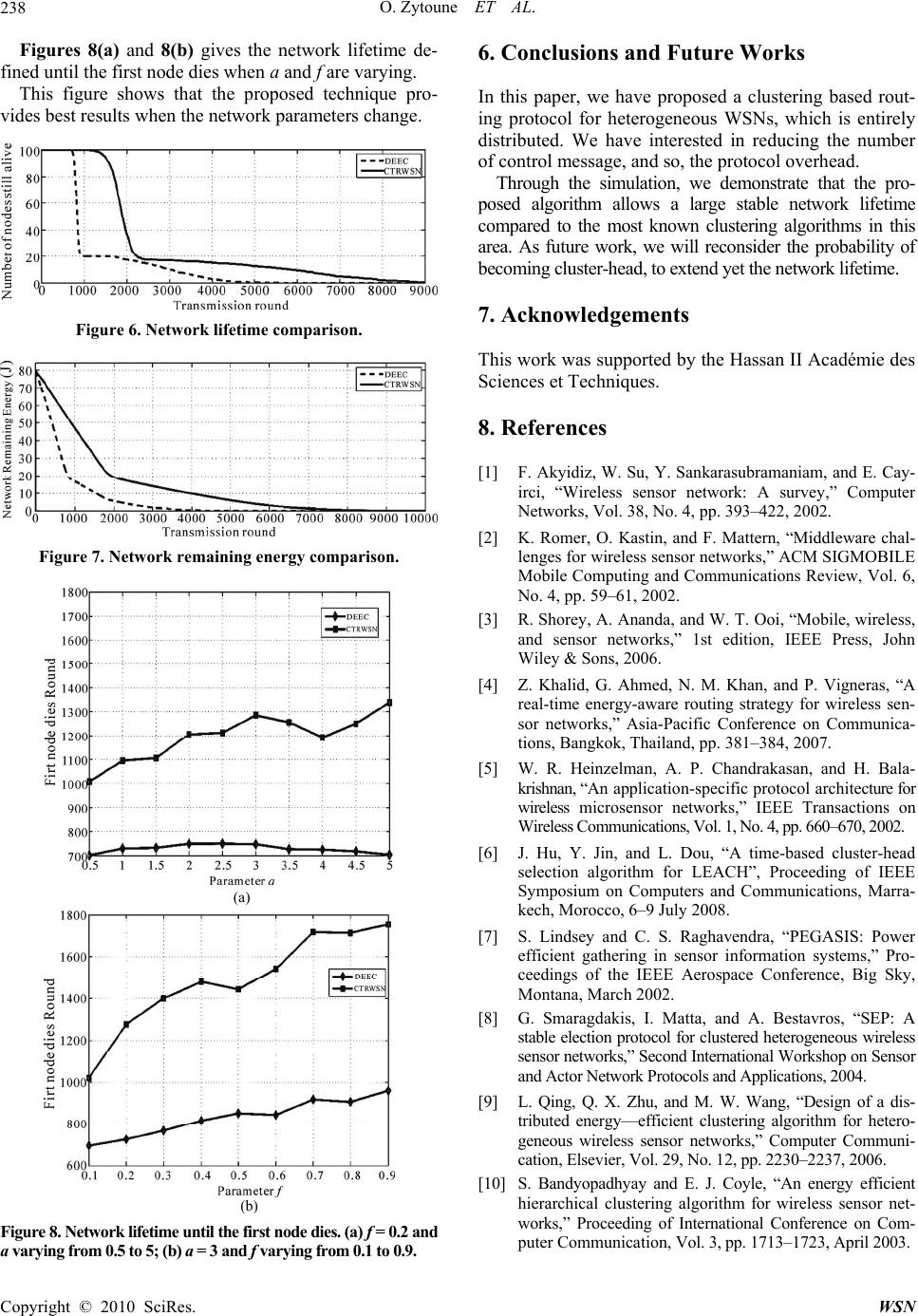 O. Zytoune ET AL. Copyright © 2010 SciRes. WSN 238 6. Conclusions and Future Works Figures 8(a) and 8(b) gives the network lifetime de- fined until the first node dies when a and f are varying. This figure shows that the proposed technique pro- vides best results when the network parameters change. In this paper, we have proposed a clustering based rout- ing protocol for heterogeneous WSNs, which is entirely distributed. We have interested in reducing the number of control message, and so, the protocol overhead. Through the simulation, we demonstrate that the pro- posed algorithm allows a large stable network lifetime compared to the most known clustering algorithms in this area. As future work, we will reconsider the probability of becoming cluster-head, to extend yet the network lifetime. 7. Acknowledgements Figure 6. Network lifetime comparison. This work was supported by the Hassan II Académie des Sciences et Techniques. 8. References [1] F. Akyidiz, W. Su, Y. Sankarasubramaniam, and E. Cay- irci, “Wireless sensor network: A survey,” Computer Networks, Vol. 38, No. 4, pp. 393–422, 2002. [2] K. Romer, O. Kastin, and F. Mattern, “Middleware chal- lenges for wireless sensor networks,” ACM SIGMOBILE Mobile Computing and Communications Review, Vol. 6, No. 4, pp. 59–61, 2002. Figure 7. Network remaining energy comparison. [3] R. Shorey, A. Ananda, and W. T. Ooi, “Mobile, wireless, and sensor networks,” 1st edition, IEEE Press, John Wiley & Sons, 2006. [4] Z. Khalid, G. Ahmed, N. M. Khan, and P. Vigneras, “A real-time energy-aware routing strategy for wireless sen- sor networks,” Asia-Pacific Conference on Communica- tions, Bangkok, Thailand, pp. 381–384, 2007. [5] W. R. Heinzelman, A. P. Chandrakasan, and H. Bala- krishnan, “An application-specific protocol architecture for wireless microsensor networks,” IEEE Transactions on Wireless Communications, Vol. 1, No. 4, pp. 660–670, 2002. [6] J. Hu, Y. Jin, and L. Dou, “A time-based cluster-head selection algorithm for LEACH”, Proceeding of IEEE Symposium on Computers and Communications, Marra- kech, Morocco, 6–9 July 2008. (a) [7] S. Lindsey and C. S. Raghavendra, “PEGASIS: Power efficient gathering in sensor information systems,” Pro- ceedings of the IEEE Aerospace Conference, Big Sky, Montana, March 2002. [8] G. Smaragdakis, I. Matta, and A. Bestavros, “SEP: A stable election protocol for clustered heterogeneous wireless sensor networks,” Second International Workshop on Sensor and Actor Network Protocols and Applications, 2004. [9] L. Qing, Q. X. Zhu, and M. W. Wang, “Design of a dis- tributed energy—efficient clustering algorithm for hetero- geneous wireless sensor networks,” Computer Communi- cation, Elsevier, Vol. 29, No. 12, pp. 2230–2237, 2006. [10] S. Bandyopadhyay and E. J. Coyle, “An energy efficient hierarchical clustering algorithm for wireless sensor net- works,” Proceeding of International Conference on Com- puter Communication, Vol. 3, pp. 1713–1723, April 2003. (b) Figure 8. Network lifetime until the first node dies. (a) f = 0.2 and a varying from 0.5 to 5; (b) a = 3 and f varying from 0.1 to 0.9. |

